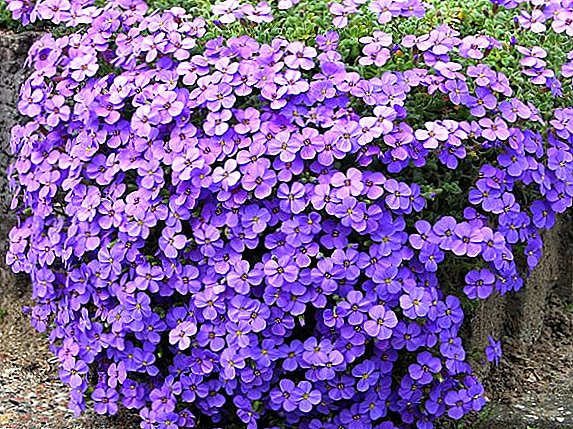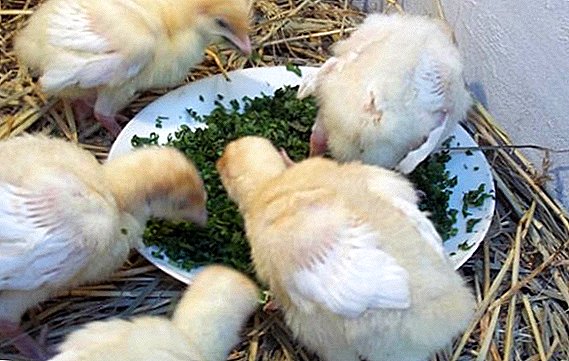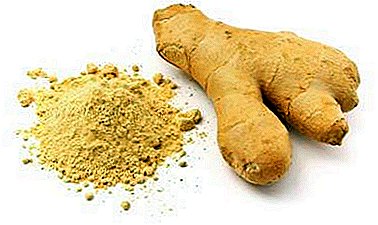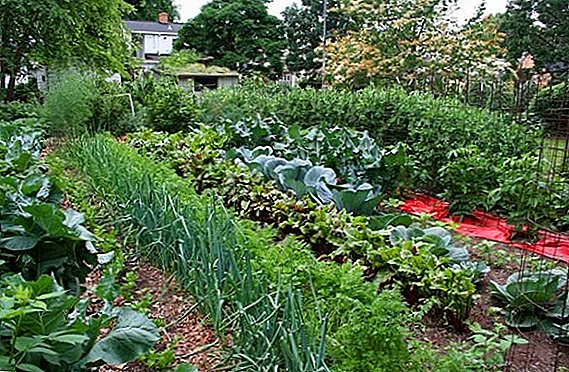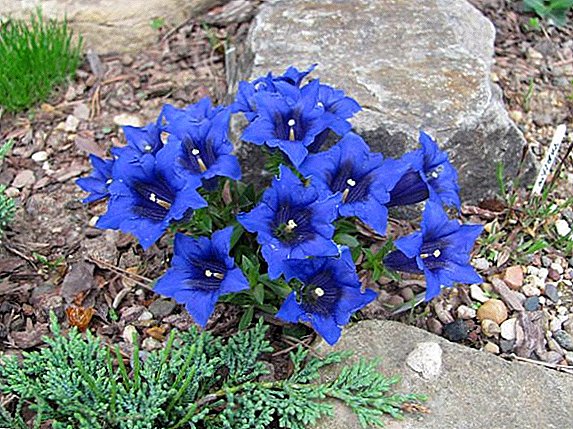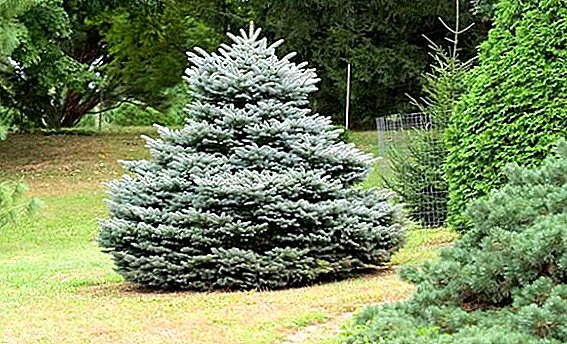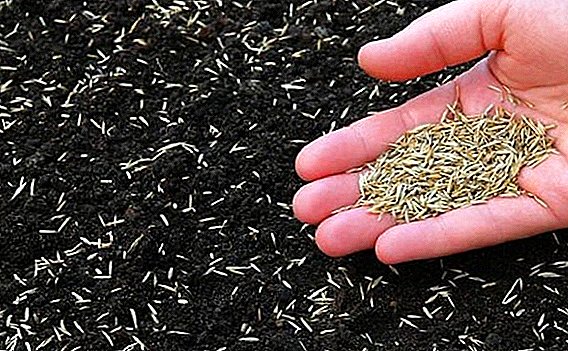 All those involved in tillage and annual planting of various garden crops face the problem of loss of soil fertility, depletion of its mineral composition and inability to produce crops just the next year after the first garden season. To eliminate this problem, various methods have been developed, including fertilization, loosening the soil, as well as planting various sideratnyh crops in the winter. And we will talk about the last method in this article, having considered various nuances of this technology.
All those involved in tillage and annual planting of various garden crops face the problem of loss of soil fertility, depletion of its mineral composition and inability to produce crops just the next year after the first garden season. To eliminate this problem, various methods have been developed, including fertilization, loosening the soil, as well as planting various sideratnyh crops in the winter. And we will talk about the last method in this article, having considered various nuances of this technology.
When is it better to land
The period when it is possible to carry out planting of sideratny cultures is considered all four seasons: spring, summer, autumn and winter. 
But at the same time, experienced gardeners and farmers often use winter crops as green manure, indicating that it is during this time that it is recommended to plant them in order to prepare the land for the new season, which begins in spring and ends in autumn.
In winter, however, the gardens, as a rule, are empty, and at this point you can take the necessary measures to maintain fertility and mineral balance in the soil.
Important! To siderata not turned into weeds, the culture must be mowed until the moment the seeds spill out of the ears. To this end, the green manure culture can be mown when it has reached 20-30 centimeters in height or during the budding period. The beveled material can be used for mulching or making so-called "green" fertilizer to the soil.
Advantages and possible disadvantages of sowing in the fall
So, the best period for planting siderats is considered to be late autumn, after the crop has been fully harvested, and the garden has been cleared of plants and ready for wintering. 
This period of planting is considered the most favorable because it has a number of advantages, namely:
- frees up time when sowing and planting early garden crops in the spring (early cabbage, carrots, potatoes and others);
- extends the period of siderats in the soil (until May), which serves to better loosen the root system of plants, the additional release of mineral salts necessary for late crop rotation;
- a rich green mass serves as a good protection against the burning spring sun and returning cold, and after mowing it is also a cover mulch.
Of the minuses, it is possible to single out only the fact that not all crops are resistant to the severe frosts of northern latitudes, and therefore part or all of the crop may die, and without giving the expected results.
The benefits of winter sideratov
Each of the many subspecies of green manure crops has its own set of positive qualities, but all of them are capable of enriching the soil with nitrogen, potassium, phosphorus and a whole range of useful microelements, which are essential for the successful fruiting and active growth of various garden and garden crops. 
In addition, siderata are an excellent means of combating underground and ground pests.
Siderats are completely unpretentious to care and are quite resistant to frequent temperature differences and their serious subsidence in the direction of frost and heat.
Did you know? The soil gradually accumulates salts when artificial fertilizers are applied, which are often used in modern horticulture and horticulture to improve yields. The consequence of excessive soil salinization is a significant decrease in their quality and inefficient productivity of all crops. This is due to the depression of earthworms by increasing the salt balance. But it is the worms that play an important role in the regeneration of nutrient minerals in the upper layers of the soil.
Technology of winter planting of siderats
One of the main rules when planting siderats is the need to sow as thick as possible, deepening the seed, depending on the grain size, 2-4 centimeters to the ground. 
In addition, there are several recommendations summarized in the following list:
- Most often, sowing works with winter greenhouse crops are carried out, dispersing the grains over the area randomly. Sometimes also pre-dug trenches are used, which are arranged in such a way that other cultures planted in the future are placed between the rows of siderats.
- It is possible to start sowing seeds of siderats into the soil immediately, as the last garden crops were removed closer to the end of autumn.
- Before starting sowing, carefully weed the area, removing weeds and remnants of past plants (tops, rhizomes, leaves, etc.)
- In the event that the land plot has been severely depleted, it is necessary to preliminarily introduce nitroammophos and phosphorus-potassium fertilizers at the rate of 30-40 g / sq. m
- If the ground requires it, you can dig up the area on the spade bayonet. This procedure can be replaced by the usual loosening of the soil with the help of sap and rake.
- If the land is overdried, watering should be carried out before sowing the sideratny cultures.
- If the garden is completely empty before November, then the method of double planting of siderats can be applied. The first sowing campaign should be carried out at the end of August, using crops with a short period of growth and development, such as legumes, peas, barley and a number of others. As soon as their sprouts reach a height of 20-25 centimeters, the greens should be cut. All stems and foliage should be processed into mulch, after which the resulting fertilizer is scattered throughout the site. Thus, before the onset of cold pores, this green will have time to turn into humus and fertilize a vegetable garden. Such a fertilizer will release a large amount of mineral compounds into the soil and enrich it with organic matter.
- The second sowing after harvesting early crops should be made with winter green manure in 2-3 decade of October. Such crops as clover, vetch, winter rye and some others are used in this crop. Before the onset of severe frost, these plants have time to develop a sufficiently powerful root system and gain growth and strength. Thanks to this soil cover, the earth is protected from the wind, and the snow, which is a natural insulant, is retained. In the spring, the re-germinating siderat helps to retain moisture in the earth and continues to supply the upper layers of the soil with mineral compounds, among which nitrogen, phosphorus and potassium are particularly important.

After plowing, you can sprinkle the garden with the remnants of mulch. Thanks to the mulching, the most acceptable conditions will be created for the successful decomposition of the root mass, which remains in the soil. After a few weeks, you can begin sowing with early garden and horticultural crops.
Important! When in the spring you plow the land along with the remnants of winter green manures, it is important not to overburden the soil last. If too much green mass remains in the ground, it will rot when exposed to moisture and heat, emitting an unpleasant sour smell and poisoning the soil. It is better to remove the green cover of the sprouted sideratov before plowing, so as not to spoil all the work done. Greens can be put on a pile to create compost: so you can use a green manure culture in all possible positive forms.
With ordinary (kulisny) sowing in spring, the above-ground mass is cut, thrown into the aisle, finely buried in the soil, and after 2-3 weeks the main vegetable crops are planted or sown in the aisle.
Culture for sowing under the winter as a sideratov
Depending on what goals you need to decide on your personal plot, you should choose a culture, the advantages of which will help to cope with the problem. 
So, in order to loosen the soil you will need to use rye or mustard, rapeseed will help to overcome rotten lesions and the progression of scab, and its combination with oats or marigolds will be even more effective.
The clover, vetch, mustard or alfalfa abundantly mineralizes the soil, but with annoying insects that parasitize in the garden, the calendula or phacelia successfully cope.
Buckwheat, alfalfa, sweet clover, phacelia, and lupine are also used as a siderata.
Let's take a closer look at each of the most popular types of winter green manures.
Winter rye
Rye is considered one of the most versatile winter green manures. If you sow its seeds in late summer or in the middle of autumn, then by the frost it will have time to gain enough strength and expand its root system for a successful wintering. 
In the spring, its stems will quickly move away from frost and a week after the warm weather has established, your site will turn green with young shoots of rye. When their height reaches 20-25 centimeters, you can use a trimmer or lawn mower to level the area and promulgate it at the same time.
Around the beginning of April, you can dig up a plot with rye, turning the stems down to fertilize the soil before planting a vegetable garden. Among the advantages of winter rye, you can include unpretentiousness to the type of soil and perfect negligence in care.
It also gives a large amount of organic matter, which also has a productive effect on the garden. Among the drawbacks is the fact that rye does not nourish the soil with nitrogen.
To sow such a siderat should not be very thick, because then it will be rather difficult to dig up such a plot. It is best to sow the rye in rows, deepening the seeds by 4-5 centimeters in the ground. The distance between the furrows should be about 15 centimeters. 
Oats
Among its indisputable advantages are: loosening the soil, controlling pests and weeds, saturating the earth with useful trace elements, including nitrogen, phosphorus and potassium, as well as suppressing various kinds of soil pathogens.
The best period of sowing oats will be early autumn, so that the plant has time to gain strength before the onset of cold weather. Oats winters beautifully, keeping all the necessary trace elements in the ground and holding the snow cover.
In the spring culture quickly begins to germinate. It also uses the rule of a 20-centimeter height of the shoots, after which the green need to be cut. Oat is an excellent universal way to maintain order in the garden.
It can be combined with almost any other sideratny cultures, thereby increasing its advantages. 
You can plant oats in furrows, which should be located, as in the case of rye, at a distance of about 15 centimeters. The depth of such grooves should not exceed 5-7 centimeters. Oats are not picky about soil and extra care.
Winter rape
Winter rape is a more gentle and unstable to temperature changes plant than rye. Also for him it will be especially destructive to have an excess of moisture, and therefore it is possible to plant such a siderat only on dry soil.
It is advisable to plant in areas that are located on higher elevations, as the lower parts are often flooded during the melting of the ice, and an excessive amount of moisture will quickly lead to the decay of the rhizome and the death of all plants.
Also, if the winter was too harsh, you should throw more snow on a piece of land planted with rape so that its roots do not freeze. 
There is a rape and its advantages - it enriches the earth with nitrogen, phosphorus and potassium, which are vital for the growth of all garden plants.
Sow such a siderat need to a depth of 2-3 centimeters, or simply dissipate the area in a chaotic manner. This culture has surface roots that will not interfere with digging in the spring.
Before the start of this process, rape should be mowed, leaving no more than 3-5 centimeters of greenery above the ground. Anything that has been mown can be used as mulch or folded onto a heap to form compost.
Did you know? According to experts from the World Health Organization, the world annually loses 6-7 million hectares of fertile land. With a further increase in the number of people (assuming that one person needs 0.3 hectares), an additional 18-21 million hectares should be plowed annually, excluding those soils that came out of the agricultural fund. Thus, the fertility of the available soil is enough for 30-35 years. Because it is important not to neglect the need to maintain the earth in proper form.
Winter vetch
The winter vetch from the family of legumes is an excellent siderarat, which is able to cope with a number of annoying pests, such as a bear or aphids, and also to provide effective assistance in weed control. 
In addition, Vika is the optimal solution for soil mineralization: it will saturate the garden with nitrogen, phosphorus and potassium, as well as a number of other important trace elements.
Among the disadvantages are the need to plant in a moist soil and then maintain it in this condition. Vika does not tolerate dry soils, unlike winter rape. One of the advantages of the winter wiki is its excellent livability with other sideratami.
It is often combined with oats, rye, superkitsey and other herbs. Vika contributes to the cultivation of most species of garden plants, with the exception of their relatives, which include all subspecies of legumes.
Plant vetch should be loose method, deepening the seeds by 1-3 centimeters. You need to plant in a well-moistened soil for 2-2.5 months before the onset of cold weather, that is, in late August or early September. 
In the spring, the culture is mown when it reaches its leaf shoots of a height of 20 centimeters, and then dug up. Its foliage is an excellent organic fertilizer for all types of soil.
As an organic fertilizer, straw, bone and fish meal, milk whey, potato peelings, egg shells, onion peel, nettle are also used.
Colza
Flowering honey plant rape has many positive qualities as siderat and quite unpretentious to the conditions of cultivation. The main thing that should be taken care of before sowing colza, is a sufficient degree of soil moisture.
For the rest, neither the type of soil, nor the acid balance, nor the presence of weeds or other insect pests frighten the rape.
This green manure wonderful flooding the earth, eliminates weedy plant varieties, and also nourishes the soil with minerals and valuable elements. Planting rape is better at the end of the harvest season, around mid-October. 
Its green mass is quickly gaining strength, and therefore it will already be quite stable and strong by the first serious frosts. Planting is carried out in rows, deepening the seeds at an average level of 5-6 centimeters.
After the trench should be covered with loose earth and slightly tamped with a special roller, sap or light pressure with the plane of the shoe sole. In spring, the seedlings are mowed, after which they plow the soil, deepening the plants into the ground as an organic fertilizer.
White mustard
White mustard is one of the few siderats that does not require further plowing into the soil. The fact is that its shoots and roots die during serious winter frosts, but they manage to do their work, retaining useful substances in the soil and saturating it with nitrogen.
The only thing that needs to be taken into account is the intolerance of white mustard to acidic and swampy soils, but for other types, it fits perfectly. Also, this siderat is perfectly combined with a number of others, including all those listed in our article. 
White mustard should be planted to a depth of no more than 3-4 centimeters, surface dispersion is also allowed. Like other sideratam, mustard should be mown until it starts to bloom and seeds start to ripen. The optimal time for landing work is the end of August.
Now you know how to preserve the mineral composition of the soil by means of planting sideratnyh crops in the soil before the start of winter and prepare it for a new garden season.
Each culture described in this article has its own advantages and disadvantages, but all of them will help to cope with the problem of regeneration of the soil composition from season to season.


